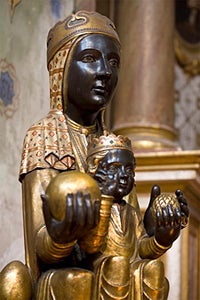“I’m trying to capture the architecture, the play of light on stone, and the beauty of the church. I try to find a way to express the spirit of the church. Sometimes I’m just moved by the shapes and the patterns.”
PJ McKey
“I’m trying to find hints of what moved the people who built the churches. And then I’m amazed by the genius of the builders.”
Dennis Aubrey

To celebrate the release of Via Lucis: Romanesque Art and Architecture in Artstor, we invited photographer Dennis Aubrey to share a history of the project.
At the core of this project to document and explore the great Romanesque and Gothic churches of France and Spain lies a mystery. At the turn of the first millennium, the French monk Raoul Glaber wrote that it seemed that “the whole world were shaking itself free, shrugging off the burden of the past, and cladding itself everywhere in a white mantle of churches.” Our question is “Who were the builders?” Who were the people who, uncompelled, built their thousands of shrines that have lasted a thousand years? Their archives have disappeared, so often we don’t even know their names. But merely knowing their names would not tell us anything about who they were and how they came to perform such tasks. What kind of belief impelled and motivated them? This is the mystery we explore.

As the 11thCentury dawned in France, the world seemed under attack from all directions. The Carolingian stability had disappeared in a wave of invasions – the Norsemen raided the rivers and coasts from the North, the Saracens ranged over the South as they crossed the Pyrenees and swept up the Mediterranean, and the Magyar horsemen invaded from Hungary and the east. Cities were pillaged, churches destroyed, and society disintegrated. The invaders actually fought battles against each other over the spoils of France. But a new society began to emerge, one led by a religious movement of profound importance.

The Christian monastic orders emerged as the mortar of society, the bond that kept it together. Through these orders, Christian Europe began to defend itself, not just in arms but philosophically. The Church needed to restate its very identity. That restatement was powerful and profound. The Christian identity was re-imagined completely, not merely rediscovered. The Church incorporated the new learning of the day – the sciences of logic and philosophy. In doing so, Christian Europe managed two monumental feats; they united faith and intellect and created a completely new architecture.
The great Abbe Angelico Surcamp of the monastery of La Pierre Qui Vire near Vezelay, recently described to us that Romanesque architecture is fundamentally monastic – inward-looking and contemplative. Gothic, he suggested, was directed outwards as a public display of faith. Yet both combined to create an architectural vocabulary that transmuted stone into an expression of man’s Belief. Our project at Via Lucis is to explore this great achievement, that of sending stone soaring to the heavens.


